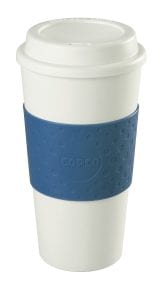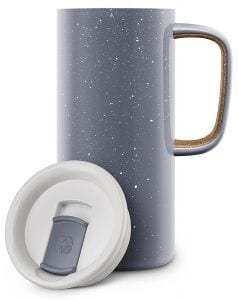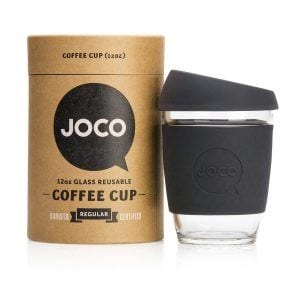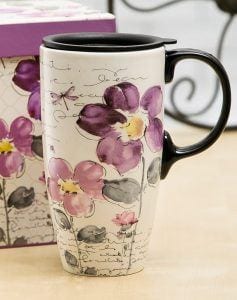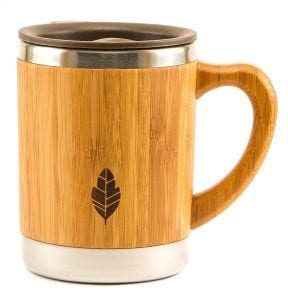Image Credit: MyHomeIdeas Stainless Steel Bamboo Travel Mug
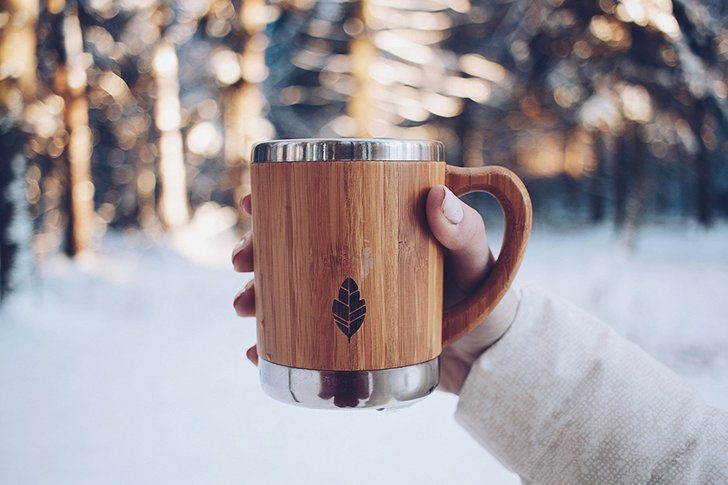
As one of the most popular beverages in the world, coffee holds a special place in our daily routines. And unlike most things that people love to love, coffee is actually quite good for you. Whether it’s the intoxicating aroma, the injection of caffeine, or just the divine mixture of heavenly flavors, coffee is an absolute necessity for many in the morning.
In fact, nearly half of Americans drink 2 to 3 cups of joe on average each day. If your daily coffee habit includes a few trips to the coffee shop, you really should consider investing in a reusable travel mug.
Here’s why.
6 Reasons You Need To Start Using A Travel Coffee Mug
1. Disposable Coffee Cups Generate a Staggering Amount of Waste
An estimated 50 billion paper coffee cups are used once and tossed away in America each year. If stacked end to end, they would reach the moon and back five times.
The sheer amount of non-recyclable coffee cup waste we create is not sustainable and is also entirely unnecessary. On an individual level, if you purchase coffee every day, by using a traveler mug instead of a paper cup, you will prevent around 23 pounds of coffee cup waste from sitting in a landfill each year.
2. Disposable Coffee Cups Can’t Be Recycled
Even though most disposable cups are made from 95% paper and 5% plastic, it may come as a surprise to many that single use cups can’t be recycled.
The holdup is the addition of a thin layer of plastic attached to the interior of the paper cup. This lining prevents the cardboard from getting soggy and helps to keep the coffee warm. Because it is practically fused to the paper cup, the lining can’t be separated at regular recycling facilities.
Back in 2008, Starbucks pledged to create a 100% recyclable, biodegradable cup by 2015. But five years after making this promise, the company cancelled the program in favor of recommending that recycling plants be upgraded to accept their paper cups – at the taxpayers’ expense.
And yet, the recyclable coffee cup conundrum is not unsolvable. In 2014, a British inventor created a disposable coffee cup made from recycled cardboard with the plastic lining added afterwards so it can be easily separated at normal recycling plants. Dubbed the Frugalpac cup, it has been trialed in Starbucks locations in the UK beginning in the summer of 2016. However, it is unclear whether the initiative was successful.
3. Disposable Coffee Cups Deplete the Earth’s Natural Resources
The plastic and paper from disposable coffee cups aren’t the only things that get thrown away once the coffee has been consumed – all of the of the resources that went into the production of the cup are tossed away as well.
At a time when we should really be planting more trees to offset carbon emissions and mitigate climate change, 20 million trees are felled each year to manufacture paper cups.
Between worsening droughts and aging water infrastructure, the era of clean and inexpensive water in the US may be coming to an end. But we still are churning out 12 billion gallons of water each year to produce throwaway coffee cups.
The energy required to manufacture and dispose of paper cups could be better used to power 53,000 homes for an entire year.
4. Drinking from Disposable Cups Could Be Putting Your Health at Risk
The thin plastic lining in paper cups is made from low-density polyethylene (LDPE) resin. Although LDPE can withstand a constant temperature of 176°F (and up to 185°F for a short time), hot drinks like coffee may be served anywhere between 180°F to 205°F. And according to a study published in 2011, when LDPE resin is stressed by heat and UV light, it leaches chemicals that have estrogenic activity; these chemicals can contribute to increased rates of ovarian, breast, prostate, and testicular cancers, reproductive problems, obesity, and early puberty.
Although paper coffee cups seem to be the most commonly used among coffee shops, some nationwide chains still use polystyrene – or styrofoam – cups to serve up their hot drinks. Polystyrene is derived from the chemical styrene, which was listed as “reasonably anticipated to be a carcinogen” by the Fourteenth Report on Carcinogens.
5. The Great Cup Versus Mug Debate
It has been argued that disposable cups require much less energy to produce and toss away than it is to manufacture and repeatedly wash reusable mugs. Based on this study, the idea is that, in order to “break even” energy-wise, a ceramic cup must be used 39 times, a reusable plastic mug 17 times, and a glass cup 15 times to compare to the energy costs of a single use paper cup.
The life-cycle energy analysis study has one major flaw, however: it was written and published in 1994. The data used to determine the energy expended during the manufacture of reusable is likely to be much more efficient in 2018. And surely dishwashing machines have improved vastly over the past 20 years to use less water and power.
Even so, if we take for granted that the figures are the same now as then, reusing a plastic coffee mug at least 17 times shouldn’t be too difficult – especially when the point of investing in a reusable coffee cup is precisely to reuse it again and again.
6. Save Money
Many coffee chains and independent cafes offer discounts for customers using their own coffee cup. While the initial outlay for a reusable cup could be $10-25, a small saving with every cup of coffee purchased could have a long term benefit on your finances.
6 Stylish & Planet Saving Reusable Coffee Cups
When it comes to reusable cups, consumers have a lot of choice in shapes, sizes, colors, and materials. Here are some of our picks:
1. Copco Acadia Travel Mug
When you want your reusable cup to look pretty much exactly like a paper cup, Copco Acadia has you covered. Made from BPA-free rigid plastic, it’s fitted with a silicone sleeve for grip and to insulate hands against the heat. Copco Acadia mugs are backed by a lifetime warranty, hold 16 ounces of hot beverage, and are dishwasher and microwave safe.
Get more details, see the color options and see the price on Amazon here.
2. Ello Stainless Steel Travel Mug
With a campy aesthetic, the Ello travel mug is a modern take on the vintage speckled tumbler. It’s vacuum insulated so it’ll keep your bevvies hot for 5 hours and cold for 10 hours. The inner part of the handle is lined with cork for added grip and the leak-proof lid features a slider for easy opening and closing.
Get more details, see the color options and see the price on Amazon here.
3. Joco Glass Reusable Coffee Cup
Made from non-porous, heat resistant borosilicate glass, the Joco coffee cup provides a sleek and attractive mug that won’t crack or shatter in boiling water. With an ergonomic lid and silicone sleeve, it comes in 8, 12, and 16 ounce capacities – the barista standard for small, medium, and large sized coffees.
Get more details, see the color options and see the price at Amazon here.
4. A Ting Ceramic Travel Mug
Looking for the comforts of home in a travelling cup? This ceramic mug, depicting a lovely array of purple flowers and dragonflies, comes with a spill proof plastic lid – perfect for whisking your coffee away out the door.
See more details and the price on Amazon here.
5. Life Story Corky Cup
Harnessing the natural insulating powers of cork, this cup is completely waterproof, won’t slip out of your hands, and will keep your fingers from getting singed. Capped with a twist on lid, it holds up to 16 ounces of coffee or tea.
See more details and get the price on Amazon here.
6. MyHomeIdeas Stainless Steel Bamboo Mug
With a bamboo wood exterior, this reusable mug is lined with high quality stainless steel to help keep your drinks at their optimal temperature. Lightweight and extremely durable, it’ll hold 11 ounces of brew.
Get more details and see the price on Amazon here.

